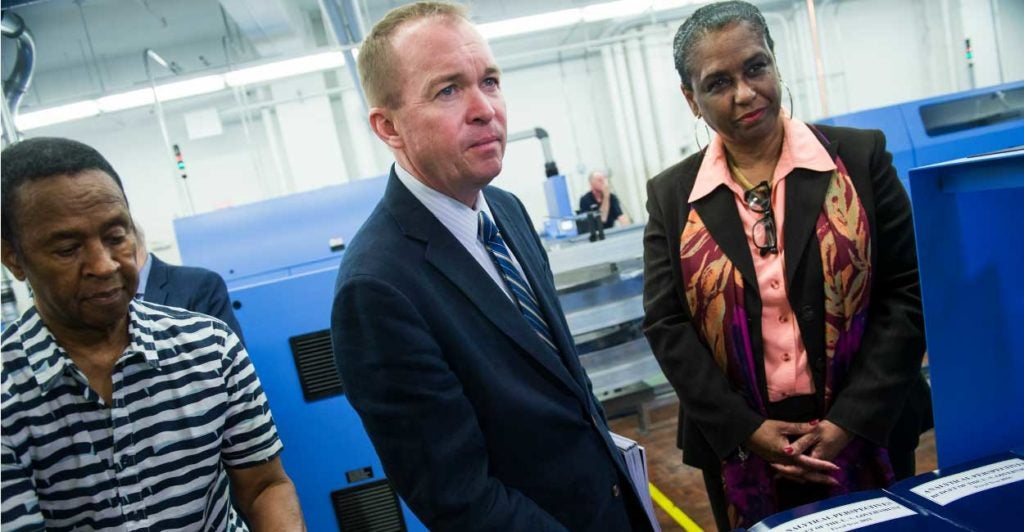The Trump administration will respect taxpayers, balance the budget, return the country to 3 percent economic growth, and push a parental leave requirement in its fiscal plan to be released Tuesday, said Office of Management and Budget Director Mick Mulvaney.
Mulvaney called it a “taxpayers first budget.”
“This budget was written through the eyes of the people paying for the budget, not through the eyes of who is getting paid,” Mulvaney told reporters Monday during an off-camera briefing at the White House.
Mulavney elaborated that budget writers went line-by-line through the budget to see what programs had a success rate and what programs didn’t.
The White House released a general outline of the plan Monday, before the full plan is released on Tuesday. The budget includes $3.6 trillion in spending cuts over 10 years, which the White House says is the most proposed by any president.
The administration’s first budget is being released while President Donald Trump is out of the country, taking stops in the Middle East and Europe.
Much of the budget policies are tied to creating 3 percent growth, or are contingent on achieving that goal. A key example is balancing a budget in 10 years, which relies on the growth goal.
“It is not unprecedented, but is below the average since the founding of the country and since World War II,” Mulvaney said. “You will never balance the budget with 1.9 percent growth.”
The growth rate could be a very optimistic assumption for balancing the budget in 10 years, said Romina Boccia, deputy director of the Thomas A. Roe Institute for Economic Policy Studies at The Heritage Foundation. Last week, she said the budget numbers are worth comparing to other estimates, such as the Congressional Budget Office.
The fiscal plan presumes the passages of both the American Health Care Act—to replace Obamacare—and of Trump’s tax reform proposal. It also includes increases in defense and border security spending—including $2.6 billion for a border wall and other border infrastructure.
The administration projects that by 2027, when the budget balances, publicly held debt will drop to 60 percent of gross domestic product. This would be the lowest level since 2010, when the Obama administration’s first budget took effect. That’s down from 77 percent of GDP. The plan further projects the national debt to continue falling.
The Trump administration’s plan puts forth a new path for welfare reforms, which Mulvaney characterized as a method to encourage the “dignity of work,” and also another way to move people out of poverty and into the workforce.
“We believe social safety net programs will help us get to 3 percent growth, because people won’t be afraid that if they take a gamble and fail, they’ll be wiped out,” Mulvaney said.
He said the reforms are simply to determine if everyone in the social programs should be on the programs.
The 10-year plan will “tighten eligibility and encourage work” for recipients of food stamps. It will limit the earned income tax credit and child tax credit to only those legally eligible to work in the United States.
The food stamp reforms are projected to save $193 billion over the next decade. Reforms to Temporary Assistance for Needy Families, or TANF, are projected to save $21 billion over 10 years and EITC and child tax credit changes will save $40 billion over 10 years, according to the budget projection. The budget outline further proposes to reform Medicaid to give states more flexibility through federal block grants.
There is a reason to be skeptical of whether work requirements—such as in Medicaid, food stamps, or housing—will have a significant budgetary impact, said Michael Tanner, a senior fellow with the libertarian Cato Institute.
“I do not think it’s a terrible thing, but savings will be really incremental,” Tanner told The Daily Signal. “I also think all the wailing and gnashing of teeth we’ll hear on the other side is too much. This will affect few people.”
“Look at TANF, which has fairly strong work requirements,” Tanner said. “Only 42 percent [of recipients] are working, with a fairly generous definition of working—job training or college. There are so many exemptions.”
He added that welfare programs shouldn’t be reformed to save money, but because they are not working.
Mulvaney said this is the first time a presidential budget proposed a fully-paid-for paid family leave proposal through building on the unemployment insurance system as a base, and allowing states to establish paid parental leave programs.
“This goes to the matter of 3 percent growth,” Mulvaney said, because more parents will feel comfortable about going back to work without fear.
Tanner said not so fast, citing laws in California, and in Europe, where laws have had the opposite effect.
“There is no such thing as a free lunch,” Tanner said. “If a business has to pay for two workers to support one, it becomes more expensive to hire women. In Britain and other European countries that have these laws, it drove down the number of women in the workforce.”
